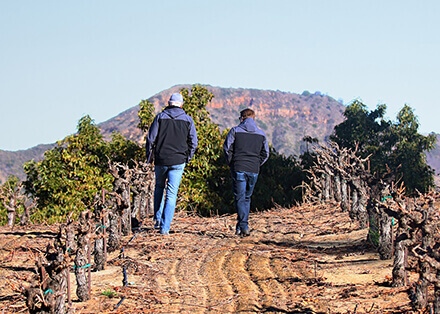Viticulture, Wine
What Does It Take to Grow Grapes on a Vineyard?
Wine has a vast history and for many countries, this versatile drink has become an intrinsic part of their culture.
Whether you enjoy a glass of wine at the end of a busy workday, get together with friends for pairings parties or are a frequent vineyard visitor, wine is readily available. So available that you may be unaware of what goes into producing your favorite bottle of wine. Today, we wanted to share what goes into growing grapes, as it requires a significant amount of time and effort.
It’s a labor of love, one that we are thrilled to share with wine lovers, one bottle at a time.
Making Wine Is a Process—One That Starts with Planting Grapevines
As Robert Louis Stevenson, the Scottish novelist, poet and travel writer, said, “Wine is bottled poetry.”
Winemaking is a creative process that requires time, knowledge and commitment. From planting to harvesting, wine grapes have an entire life cycle.
Depending on the vineyard and the wine they wish to produce, it’s essential to assess the microclimates to understand which grapes will flourish. When planting baby vines, the process ahead is challenging. Over the next several years, producers must give their vines plenty of attention and care. Watering, pruning and pest control are just a few examples of the required tasks.
For example, if you do not correctly prune vines, you will not get high-quality grapes, which means you can’t make quality wine. The art of pruning is such a skill that pruning contests are held in California each year. Following the dormancy stage, when pruning is the critical area of focus, buds begin to appear in early spring. During this is when temperatures need to be on your radar. Vineyards use several strategies, including giant wind machines to circulate cold air, massive sprinklers, you name it.
Then there’s the fruit set stage, the veraison period, followed by harvesting season — which requires knowledge of when specific grape varietals are harvested. The harvesting process also typically begins in the wee hours of the morning, around 3:00 am or so. Starting early helps protect the grapes from the heat of the day ahead. Each stage requires a significant amount of time and energy.
Learn more about why Sweet Oaks uses bee netting after veraison. This alone shows how crucial each step can be.
There are plenty of things that can go wrong along the way. After all, this process takes years and Mother Nature throws in many variables. However, when those who are skilled and knowledgeable have the right growing conditions, they will eventually pick grapes. There is plenty of work ahead to turn those grapes into wine when they do.
Bottom line—growing grapes requires hard work, long hours and skill.
Not All Vines Are Grown Equal
There are plenty of how-to guides online for growing backyard grapes, which is excellent! However, there’s a monumental difference between vines that are alive and vines that produce grapes ideal for fine wine. There is so much science involved in this process that viticulture, which is the cultivation and harvesting of grapes, is a common program offered at universities worldwide.
For example, fine wine doesn’t need to be expensive, but it must be made from top-quality grapes grown under excellent conditions. An ideal climate and the correct soil composition are crucial to producing such wines. These variables influence an area’s terroir, which is expressed in well-made wines.
That is why when it all boils down, exception wine is grown, not made. Without great grapes, you can’t make great wine.
Why Temecula Valley Is Perfect for Wine Grapes
Many are surprised that world-class wines are produced in Southern California. Isn’t it too hot?
Like Southern Italy, many parts of Spain and Napa Valley, Temecula Valley is blessed with a Mediterranean climate. This climate yields a long growing season of moderate to warm temperatures, relatively low rainfall and mild winters. Cold ocean currents influence the climate in the summer. So, although the days are warm and sunny, the nights are much cooler. Most of the region’s precipitation falls during the winter months.
The key to the exceptional grapes grown in Temecula Valley is the region’s long, sunny days and proximity to coastal mountain ranges and valleys.
The result?
Optimal growing conditions thanks to warm days full of sun, comfortable and breezy afternoons, followed by cool nights. It’s the perfect recipe for grapes that yield complex flavors and aromas, balanced by ideal acidity levels.
Sweet Oaks Is Nestled in the Heart of Temecula Valley
Sweet Oaks is located in the Temecula Valley Wine Country. Here, we enjoy a unique growing climate and rich soil — but that’s only half the battle. Since Sweet Oaks was first founded in 2015, we have not only produced excellent wine grapes, but we have also created an exquisite collection of wines we’re proud to call ours.
We welcome you to read the story of Sweet Oaks and try the fruits of our labor, or come visit the winery and schedule an in-person wine tasting today!



